Timetable for our review
Stage one – development of initial proposals
2.16 We began this review in January 2021. We published electorate data from 2 March 2020 (the relevant date specified by the legislation) for each local government ward in England, including – where relevant – wards that were prospective on 1 December 2020. The electorate data was provided by individual local electoral registration officers and the Office for National Statistics. These figures are available on our website. The Commission then considered the statutory factors outlined above and drew up the initial proposals. We published our initial proposals for consultation for each of England’s nine regions on 8 June 2021.
Back to topStage two – consultation on initial proposals
2.17 We consulted on our initial proposals for eight weeks, from 8 June 2021 until 2 August 2021. We received over 34,000 discrete written representations across the country as a whole, including over 1,900 unique written representations relating to Yorkshire and the Humber. We are grateful to all those who took the time and effort to read and respond to our initial proposals.
Back to topStage three – consultation on representations received
2.18 The legislation required us to publish all the responses we received on our initial proposals. We published the representations on 7 February 2022 ahead of a six-week ‘secondary consultation’ period, which took place from 22 February 2022 until 4 April 2022. The purpose of the secondary consultation was for people to see what others said in response to our initial proposals, and to make comments on those views, for example by countering an argument, or by supporting and reinforcing what others said. We received over 10,000 unique written representations across the country as a whole, including over 600 unique representations relating to Yorkshire and the Humber. We also hosted between two and five public hearings in each region. We heard more than 120 oral representations at the three public hearings in Yorkshire and the Humber. We are grateful to all those who attended and spoke at our public hearings.
Back to topStage four – development and publication of revised proposals
2.19 As we detail in chapter 3 below, having considered the evidence presented to us, we have decided that the evidence is such that it is appropriate to revise our initial proposals in some areas. Therefore, as we are required to do under the legislation, on 8 November 2022, we are publishing this report – Revised proposals for new constituency boundaries in the Yorkshire and the Humber region – alongside eight others, one for each of the other regions in England. We are consulting on our revised proposals for the statutory four-week period, which closes on 5 December 2022. Unlike the secondary consultation period, there is no provision in the legislation for further public hearings. Chapter 4 outlines how you can contribute during this consultation period. It should be noted that this will be the final opportunity for people to contribute their views during the 2023 Review.
Back to topStage five – development and publication of the final report and recommendations
2.20 Once the consultation on revised proposals has closed on 5 December 2022, we will consider all the representations received at this stage, and throughout the review, before determining our final recommendations. The recommendations will be set out in a report to the Speaker of the House of Commons, who will lay it before Parliament, at which time we will also publish the report. The legislation states that we should submit that report to the Speaker by 1 July 2023. Further details about what the Government must then do with our recommendations in order to implement them are contained in our Guide to the 2023 Review.
2.21 Throughout each consultation period, we have taken – and are continuing to take – all reasonable steps to publicise our proposals, so that as many people as possible are aware of the consultation and can take the opportunity to contribute to our review of constituencies.
Back to top